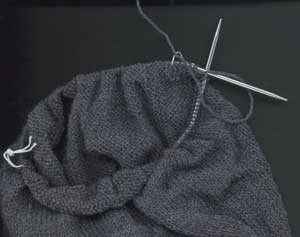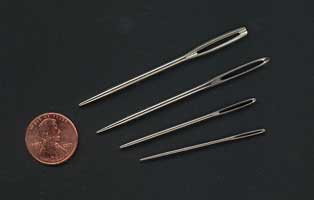Please use wool! See the American Wool Council list of suppliers [now a web site]

These may be made of several materials such as plastic, aluminum, or lucky you, bone, ivory, or rare woods. The 10 inch size is most appropriate for this class. They come in sets of 2 and are used for back and forth knitting. Readily available in knit shops, department, and variety stores.
[This is something that has changed. Craft stores, including good yarn shops, seem to be fewer now. Fortunately Internet and mail order are available.]

These have points on either end and come in sets of 4 or 5. The 7 inch length is common and useful for socks, but they can come in longer lengths. They are used for socks, mittens, gloves, sleeves, and other small diameter circular knitting.
[I now buy sock needles two sets at a time and knit each sock or mitten of a pair simultaneously from separate balls of yarn.]


These come in 16", 24", and other lengths and can be used for both back and forth knitting and circular knitting. Both ends are pointed and connected by a flexible, usually nylon, cable. Very useful and versatile but can be harder to find, you may need to mail order these.

These look like a large, blunt tip sewing needle. The eye should be big enough to take several strands of yarn. Used for weaving or Kitchener stitch, binding in loose ends, closing the tops of hats. They are inexpensive and can be found in many craft or department stores.

These look like a small diameter sock needle with a kink or bend in the middle. They are used for holding stitches while crossing cables and other Aran-style patterns.

Try to find one about the same size or slightly smaller than the diameter of your knitting needles. Often size F to I work well for knitting worsted yarn. Used to pick up dropped stitches or add a finished edge to garments.

A piece of metal or plastic with graded holes (US or metric sizes) used to measure needle sized. This is essential if you have more than one set of sock or circular needles.
The swift is used to hold yarn while winding balls from skeins for knitting. They can be rather expensive, but are welcome if you spin or dye your own yarn. Reels are used to wind yarn into skeins. Both can be improvised in a pinch.

These can be special plastic split rings, paper clips, safety pins, or loops of scrap yarn or string. They are helpful to mark increase or decrease points in circular knitting, where patterns start, etc.
Take notes while you work. Record things such as sizes, new techniques, snippets of yarn, gauge, needle sizes, etc.
[I have kept these for years, some of the most special are cards where I traced the hands of small children (who are now adults!) for knitting mittens. I now tend to keep knitting and crochet patterns as computer files and print copies to mark up each time I use them.]

This is useful for charting your own color patterns or knit and purl (Guernsey style) patterns. If your local yarn or craft store doesn't have it in the rectangular grid, it can be mail ordered.
[Or, download and print my PDF file.]

Measure often!
It helps to have a place to keep your materials, tools, and note card with pattern together. Knitting is quite portable, having a convenient carrier lets you indulge while attending meetings, waiting for appointments, and take advantage of those odd times when you can knit a row or two.